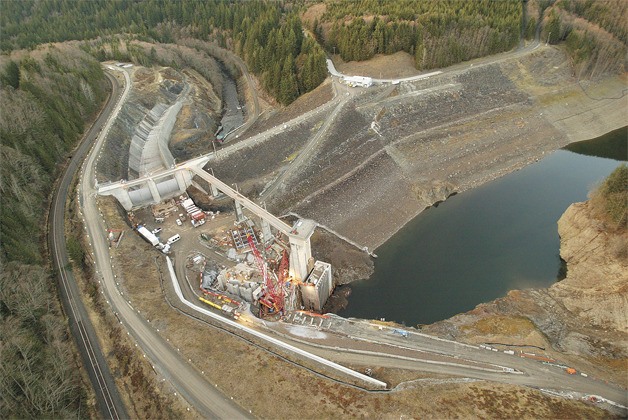Even though the flood risk of the Green River is lower than it was last winter, the U.S. Army Corps of Engineers still needs to complete repairs over the next two years to get the Howard Hanson Dam back to full operating capacity.
“Folks still need to get ready and be ready,” said Casondra Brewster, an Army Corps public-affairs specialist in Seattle. “We are not out of the woods yet.”
The corps has lowered the threat of Green River flooding this winter to 1 in 60 from 1 in 33 last year, owing to a grout curtain installed last year that stood up to summer tests to allow for more storage capacity in the reservoir behind the dam.
That means more protection from the dam for homes and businesses in Auburn, Kent, Renton and Tukwila in the valley. But the mild winter of last year could be followed by a much wetter winter this year.
The odds of flooding are 1 in 140 when the dam is fully operational. An additional $44 million in repairs, including more drains and the extension of the existing drainage tunnel to put the dam back at its top level, will not be completed until after this flood season. The federal government provided the $44 million for the repairs.
“Once work is finished by the end of 2012, that should put us back close to 1 in 140,” Brewster said.
The grout curtain installed last November helped control the problems with water storage behind the dam the corps discovered when a 10-foot-wide depression formed on the embankment next to the dam after heavy rains in January 2009. The Corps stored a record amount of water in the reservoir during that storm to prevent flooding.
If a storm strikes this winter that’s similar to the January 2009 storm that damaged the abutment, the Corps might have to release water from behind the dam, and that could cause the Green River to flood.
“That would give us some challenges,” Brewster said. “We had a record-breaking reservoir that year when we got to 1,189 feet.”
Corps engineers tested the grout curtain over the spring and summer by raising the level of the reservoir. They were unable to do that test last winter because the reservoir needed to stay low in case of heavy rainfall.
“We put it through its paces to see how it would perform,” Brewster said.
The Corps came away pleased with the performance of the grout curtain and decided that a concrete cutoff wall would no longer be necessary.
Work is expected to start before the end of this year to rehabilitate the existing tunnels at the dam.
“We plan to have boots on the ground before the end of the year and finish by summer (2011),” Brewster said.
Crews also will construct a tunnel spur to extend the existing drainage tunnel and improve the capacity of the dam. Crews could have that project done by 2012.
A landslide nearly 10,000 years ago formed the abutment next to the dam. The federal government built the rock-and-earth-fill Hanson dam in 1961 next to the abutment to control major flooding in the Green River Valley and the cities of Kent, Auburn, Tukwila and Renton.
The Corps will watch the dam much closer should storage reach the 1,147 elevation this winter. Engineers will monitor the dam 24/7 if the pool elevation is expected to reach 1,170 feet.
Armed with weather and river forecasts, engineers and meteorologists at the Reservoir Control Center at the Army Corps office in South Seattle will help Col. Anthony Wright, commander of the Seattle district, decide when to release water and how much to release.
“He (Wright) will look at the data available and what the weather is going to do, how the dam is performing and any issues it might have,” Brewster said. “We may have to release more water.”
Wright expects to be able to give local government officials as much as 24 to 36 hours notice of a potential flood event. Local officials would decide what type of emergency steps to take, including the possible evacuation of residents.
For more information, go to www.nws.usace.army.mil.


